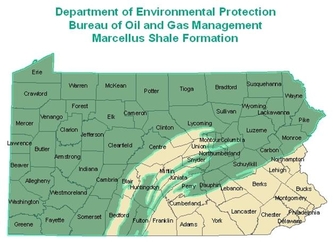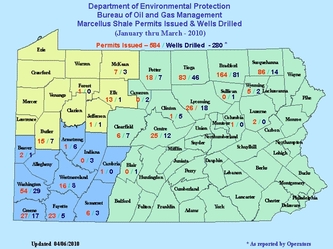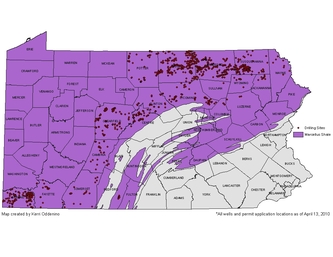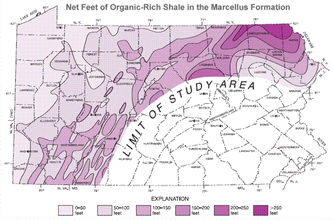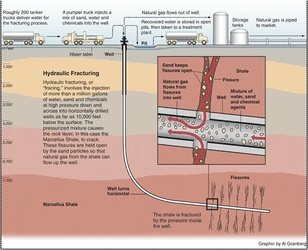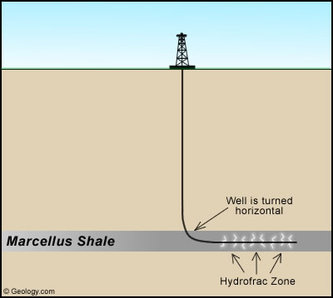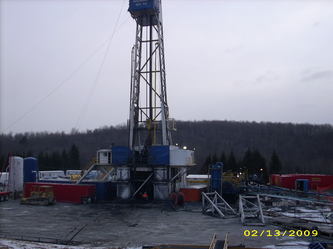Marcellus Shale
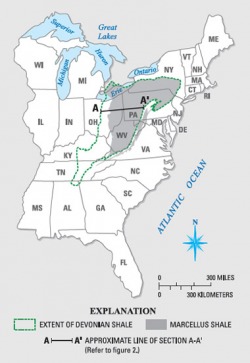
The Marcellus Shale rock formation, which was discovered in Marcellus, New York, underlies much of Pennsylvania, New York, Ohio, and West Virginia. In Pennsylvania, specifically, the Marcellus Shale formation lies under approximately 40 of the state's 67 counties. Areas where the shale extends the deepest are especially of interest to natural gas companies because they contain a greater extractable volume of gas.
.
.
The Current Debate
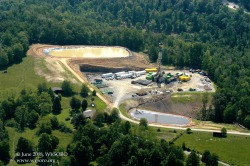
Natural gas drilling in the Marcellus Shale region recently became economically feasible because of the technique of horizontal drilling, used in conjunction with the process of hydraulic fracturing, to extract natural gas from the thin Marcellus rock formation. Natural gas companies have been quick to step on this bandwagon and Pennsylvania has witnessed a recent influx in natural gas leases and permits.
Natural gas companies can buy the mineral rights to the land, which allows them to extract the natural gas from beneath. Often, these mineral rights were sold by the individual landowners generations ago. These landowners who do not own the mineral rights to their land cannot claim any share in the profits associated with natural gas drilling on their land. Only the landowners with mineral rights receive signing bonuses, which are hefty sums of money for signing a lease that allows the natural gas company to build a drilling pad, a well head, a road, and other necessary structures on their property. These landowners also receive royalty payments based on the amount of gas produced from their land, once the well begins producing gas. The signing bonuses and royalty payments are often an enticement tool for struggling farmers in regions with Marcellus Shale. Natural gas companies also assert that natural gas drilling creates an economic boom and creates secondary jobs that are important to local economies.
Along with these economic benefits, however, there are environmental costs that must be dealt with. The hydraulic fracturing process uses millions of gallons of water per day per well; this water is drawn from local streams and rivers. The hydraulic fracturing waste-water that returns to the surface contains high salt content and a mixture of chemicals and must be disposed of properly. Accidents have also been known to happen that cause contamination of local streams and groundwater. In addition, drilling pad sites can increase local air pollution.
Natural gas companies can buy the mineral rights to the land, which allows them to extract the natural gas from beneath. Often, these mineral rights were sold by the individual landowners generations ago. These landowners who do not own the mineral rights to their land cannot claim any share in the profits associated with natural gas drilling on their land. Only the landowners with mineral rights receive signing bonuses, which are hefty sums of money for signing a lease that allows the natural gas company to build a drilling pad, a well head, a road, and other necessary structures on their property. These landowners also receive royalty payments based on the amount of gas produced from their land, once the well begins producing gas. The signing bonuses and royalty payments are often an enticement tool for struggling farmers in regions with Marcellus Shale. Natural gas companies also assert that natural gas drilling creates an economic boom and creates secondary jobs that are important to local economies.
Along with these economic benefits, however, there are environmental costs that must be dealt with. The hydraulic fracturing process uses millions of gallons of water per day per well; this water is drawn from local streams and rivers. The hydraulic fracturing waste-water that returns to the surface contains high salt content and a mixture of chemicals and must be disposed of properly. Accidents have also been known to happen that cause contamination of local streams and groundwater. In addition, drilling pad sites can increase local air pollution.
Additional Links
The Marcellus Shale Formation Information Site
Pennsylvania Campaign for Clean Water - Environmental Impact
Pennsylvania Campaign for Clean Water - Environmental Impact
